Minnesota
GRAND PORTAGE Band of CHIPPEWA INDIANS |
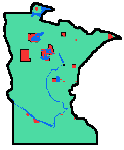 |
|---|---|
|
Federally recognized
Cook county, Minnesota
Well before the present casino-building frenzy, one of Grand Portage's most respected tribal members, Dick Anderson, enabled the tribe to gain some employment and other income from tourists to the beautiful region where -- on the very tip of the peninsula -- Grand Portage National Monument is located with reconstructed trading post. Anderson had gained a high position in Minnesota banking and finance, where his financial acumen was respected and he had many contacts. In the late 1970's, e helped his tribe obtain financing to build a luxury hotel and conference center. His contacts in the business community led to its frequent use as a retreat for businesspeople holding conferences or executive training sessions. The Lodge's restaurant features Indian foods. An indoor and (for summeers) lawn tennis court are available, and ther eis an indoor swimming pool.
There is also a tribal construction company (including some heavby equipment) that employs 25 people. Aside from sport fishing, 5 tribal members are employed in commercial fishery on Lake Superior waters, as guaranteed by treaty rights. A small number of tribal members do seasonal logging (mostly birch and poplar). The tribe operates a sawmill and pallet plant, both for tribal use and outside sales, employing about 25 people. Other tribal operations include the Grand Portage Trading Post, a marina with boat rentals and launch facilities, that runs summer excursions to Isle Royale park. The beautiful scenery for hiking and cross-country skiing remains the areas biggest draw. Grand Portage got its name because the river there, which divides Canada and the U.S. now, becomes impassable for many miles with rapids a series of high waterfalls unlike any place else in Minnesota. Indians -- and later the French voyageur fur trader expeditions had to portage an 8-mile trail around it. Long an attraction for the booming North Shore tourist industry that features gourmet-catered overnight hiking and ski trips, ski resorts and lusury tourist inns, the beautiful scenery on Minnesota's most spectacular reservation brought little income to the Indian people except occasional stints as guides. Anderson's vision, and his ability, through his high position and many contacts, made it really possible for the tribe to share in the profits of tourists.
EPA approves joint water quality agreement with Grand Portage rez, August 1996 This is another Indian "first". The Environmental Protection Agency's agreement acknowledges the fact that Grand Portage tribe "has the technical capability to perform" the scientific monitoring and other activities of trying to protect ground water, rivers and lakes, and most importantly, do their part in attempting to protect the Lake Superior fish against an oriental invader which has ridden in and established itself in the water ballasts of summer freighters, coming to the industrial ports of Duluth and Superior. Grand Portage National Monnument facts, U.S. Park Service -- the U.S. National parks service offers these facts (no photos or maps) about one of the least-known National monuments. Grand Portage -- tour old fort, casino info, pix northshore tourist service web notes that there are Indian attractions and accomodations, among the many luxury inns, parks and campgrounds of the North Shore area. Photos feature the old fort and the casino. Chippewa Treaty Rights -- game, fishery, water etc. A publication of Great Lakes Indian Fishery and Wildlife Commission (an inter-tribal, interstate body made up of representatives from Great Lakes tribes -- mostly Ojibwe -- on both sides of the Canadian border). Grand Portage's participation in the Minnesota 1856 Authority (a hunting-fishing regulatory body of 2 tribes signatory to that treaty concerning off-reservation reserved hunting and fishing rights) is discussed. | |
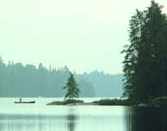 Misty day, canoe seen in the distance over evergreen-surrounded waters with little islands -- it might be a long-ago portrait of an Anishinaabe fishing on one of the lakes that dot the beautiful Grand Portage reservation, at Minnesota's most northeasterly point
Misty day, canoe seen in the distance over evergreen-surrounded waters with little islands -- it might be a long-ago portrait of an Anishinaabe fishing on one of the lakes that dot the beautiful Grand Portage reservation, at Minnesota's most northeasterly point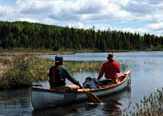 But canoeing is still a popular recreation in this area, where tourism is a prime source of income for the reservation, remote as it is (150 miles by road from Duluth, Minnesota's most northerly substantial-sized city).
But canoeing is still a popular recreation in this area, where tourism is a prime source of income for the reservation, remote as it is (150 miles by road from Duluth, Minnesota's most northerly substantial-sized city).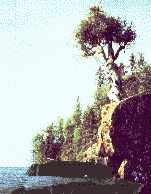 Grand Portage has also made an effort to protect something from tourists, too. At left is shown a 500-year-old cedar tree (red cedars are in general sacred to Ojibwe people). Gnarled by cold winds shhrieking in off of Lake Superior, it clings to the edge rocky shore cliff and lives alone with seemingly no need for the soil sustenance and protection this species usually requires. With their usual crassness about whatever Indian people regard as sacred, white people named this venerable tree "witch tree&". It was endangered by vandalism, and summer litter. Though it grows outside the boundaries of the reservation, the tribe has taken steps to protect it.
Grand Portage has also made an effort to protect something from tourists, too. At left is shown a 500-year-old cedar tree (red cedars are in general sacred to Ojibwe people). Gnarled by cold winds shhrieking in off of Lake Superior, it clings to the edge rocky shore cliff and lives alone with seemingly no need for the soil sustenance and protection this species usually requires. With their usual crassness about whatever Indian people regard as sacred, white people named this venerable tree "witch tree&". It was endangered by vandalism, and summer litter. Though it grows outside the boundaries of the reservation, the tribe has taken steps to protect it.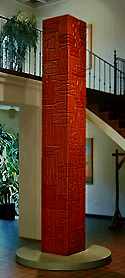 George Morrisson, well known Grand Portage artist, has experimented with modern forms of sculpture. This "Red Totem" is one of a series of totem wood sculptures that have simple geometric forms -- except that they are entirely composed of a jigsaw fitting of small carved wood blocks -- from different kinds of trees -- using different textures in a wide variety of geometric forms. All is stained red with natural plant and earth dyes. This sculpture is owned by the prestigious Heard Museum in Arizona. It is one of the artworks featured in a recent book on Native art. The Grand Portage reservation has been called "an artist's paradise" because of its scenic beauties which may be visited without crowds, litter and the usual disappointments (most of the tourist-frequented parks are southwest of the reservation). No artist can doi more than faint copies of these wonders, so Morrisson has chosen instead to sculpt spiritual impressions.
George Morrisson, well known Grand Portage artist, has experimented with modern forms of sculpture. This "Red Totem" is one of a series of totem wood sculptures that have simple geometric forms -- except that they are entirely composed of a jigsaw fitting of small carved wood blocks -- from different kinds of trees -- using different textures in a wide variety of geometric forms. All is stained red with natural plant and earth dyes. This sculpture is owned by the prestigious Heard Museum in Arizona. It is one of the artworks featured in a recent book on Native art. The Grand Portage reservation has been called "an artist's paradise" because of its scenic beauties which may be visited without crowds, litter and the usual disappointments (most of the tourist-frequented parks are southwest of the reservation). No artist can doi more than faint copies of these wonders, so Morrisson has chosen instead to sculpt spiritual impressions.